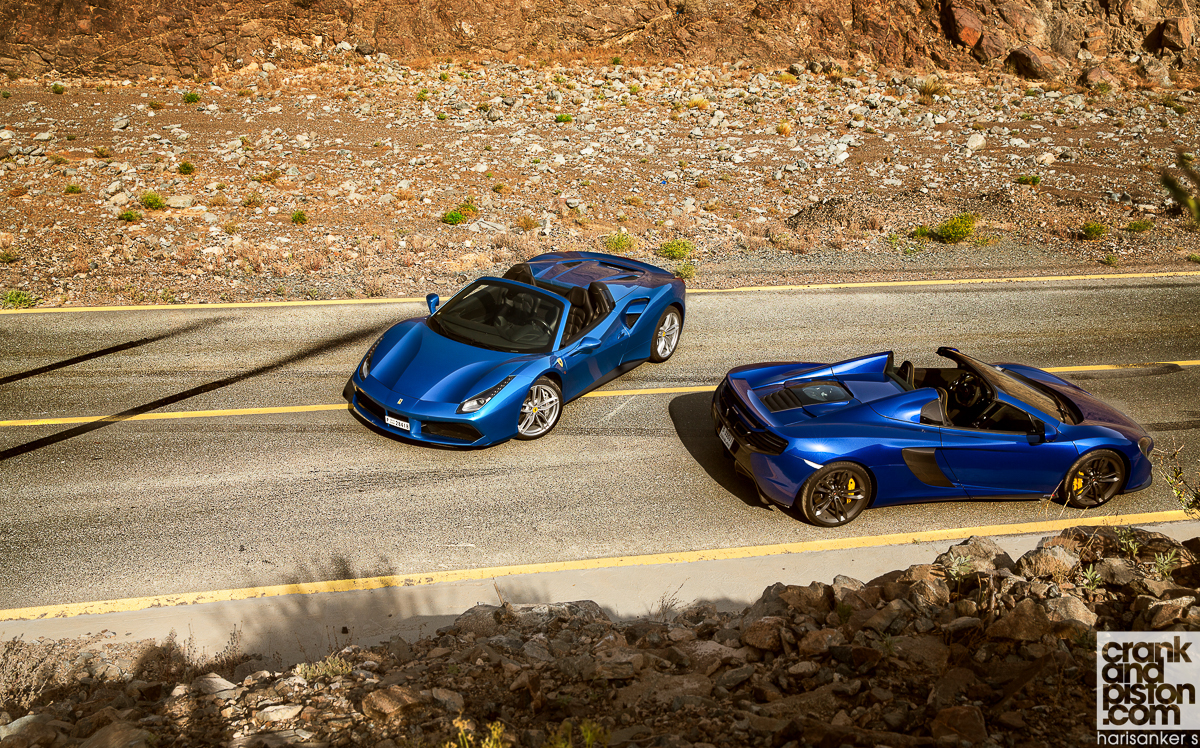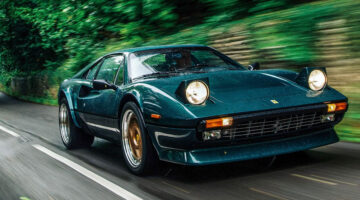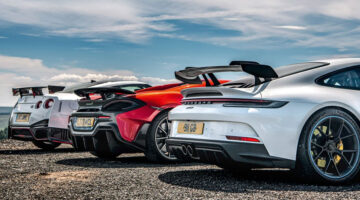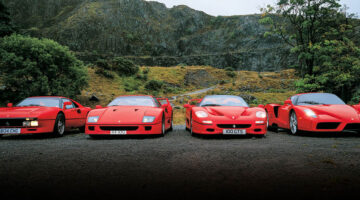Ferrari and McLaren have waged war for half a century, on-track and off. Time to pit the 488 Spider against the 650S Spider to end this rivalry once and for all…
| McLaren | Engine | Power | Torque | 0-100kph | Top speed | Weight | Basic price |
|---|---|---|---|---|---|---|---|
| Ferrari 488 Spider | V8, twin-turbo, 3902cc | 661bhp @ 8000rpm | 560lb ft @ 3000rpm (7th gear) | 3.0 secs | 330kph+ | 1475kg (455bhp/ton) | $313,200 |
| McLaren 650S Spider | V8, twin-turbo, 3799cc | 641bhp @ 7250rpm | 500lb ft @ 600rpm | 2.9 secs | 329kph | 1330kg (482bhp/ton) | $285,000 |
Nemeses. Discounting mortgage, I’ve never had one myself. Look closely at most cultural aspects of life though and you’ll find at least one: for every Batman, there is a Joker; every Guns n’ Roses, a Nirvana; every fan of top-rate cinema, an Adam Sandler. And in the motoring world, no rivalry is bigger than that of Ferrari and McLaren.
By the time Bruce McLaren had turned his team’s first wheel in anger at the 1966 Monaco Grand Prix, Enzo Ferrari’s outfit was already an established motorsport giant, having amassed 38 victories and eight combined championships in motorsport’s elite class alone. One more ‘garagista’ on the grid was hardly of concern for Il Commendatore. Thirty years later though, it was a very different picture. Engineering wizardry and some of the best engine-driver packages in history meant McLaren’s championships numbered 16 to Ferrari’s 17, Woking just three victories behind Maranello – 103 to 106 – despite the 16-year head start. Then came the McLaren F1.
Pulling 618bhp from a BMW V12, the first ever McLaren road car was unconventional in many of its workings, three way seating and a carbon fibre monocoque chassis to name just two. It was also – take a bow Gordon Murray – phenomenally quick. A recorded top speed of 240.1mph (386.4kph) shattered the world record for production cars in 1998, a record Woking held until Bugatti arrived with the Veyron in 2005. Technically and mechanically superior with public support to match, the F1 was a tough benchmark against which Ferrari’s new F50 – already failing to win critical support as the F40’s successor – was struggling.
“One more ‘garagista’ on the grid was hardly of concern for Il Commendatore”
Even on-track, McLaren’s race-spec F1 GTR devastated the ’95 and ’96 BPR Global Series against Ferrari’s F40 LM, victory at Le Mans in ’95 a particular slap to the face. Such is the F1’s legacy, it would be 13 years before the next McLaren road car appeared, the 2009 MP4-12C. Surprise surprise, the Ferrari 458 Italia – itself only two years old but already a sales behemoth – lay firmly in the crosshairs. Today both the 458 and 12C are long gone, the rivals’ latest bout involving Ferrari’s recently launched 488 Spider and McLaren’s 650S convertible (the respective First Drives of which are HERE and HERE). They’re two of the best-performing supercars on-sale today, two of the most desirable 330kph-plus convertibles money can buy, and – offering a balance between performance and day-to-day refinement – should prove just as intriguing a contest on-road as the brands’ on-track rivalry has done for five decades.
So, Ferrari or McLaren, 650S or 488 Spider. Which of these giants has the edge?
ON PAPER
As supercar comparisons go, the 488 and the 650S are closer than most. Both for instance house a twin-turbocharged V8 producing 600bhp-plus, both of which are mated to seven-speed dual-clutch automatic transmissions that send said power to the rear wheels. They both feature carbon ceramic brakes, active aerodynamics, and motorsport inspired adaptive suspension through their double wishbone configurations. Unsurprisingly, for two companies with such a vested interest in each other, their true worth lies in the details.
The Ferrari’s 3.9-litre V8 for instance is 103cc larger in capacity than the McLaren’s 3.8-litre, and boasts 661bhp compared with the 650S’ 641bhp, 561lb ft to McLaren’s 500lb ft of torque. The pair are level-pegging as they hit 100kph from standstill in three seconds flat, though thereafter the McLaren ekes out a one-tenth gap to 200kph before strolling onto a 329kph top speed, 4kph more than the Ferrari.
“Unsurprisingly, for two companies with such a vested interest in each other, their true worth lies in the details”
Scratch deeper though. Despite Ferrari’s top end torque only being accessible in seventh gear, it offers more emphatic – and potentially more characterful – punch compared with the McLaren’s more progressive build-up. Ferrari favours a space frame chassis comprising 11 different aluminium alloys, a notable departure from the 23 per cent less flexible 458. McLaren’s carbon fibre MonoCell in the 650S meanwhile is an updated, and lighter, version of the already well-established base found in the 12C. It’s a more restrained course of action compared with Ferrari’s more flamboyant though admittedly highly technical approach. Open those scissor doors and you can see examples of this inside too.
DESIGN
Car design being the subjective minx it is, I’ll leave you to flood internet message boards with your opinions and focus exclusively on cabin design and practicality. Don’t get me wrong, when dealing with two ‘5 Star’ supercars, elements like ride comfort and cabin civility should be taken with a pinch or two of salt. And yet somehow, both Ferrari and McLaren have managed to nail a damn-near perfect balance: they boast legitimate track potential yet both offer enough pliancy in the suspension to soak up even the choppiest of road surfaces, and enough comfort to make the heftiest of journeys a piece of the proverbial.
Dive into the details once again though, and the innate character of both Ferrari and McLaren begin to shine. The 488 for instance is considerably more outlandish than the 650S, all sharply angled dashboards, beautifully cut leather upholstery, chrome-detailed ‘488 Spider’ emblems, centre-mounted carbon fibre floating ‘wings’ above the transmission tunnel, and hexagonal multifunction steering wheels. It’s awe-inspiring stuff, as you would expect from the prancing horse. And then there’s the more restrained approach in the 650S, which, in spite of that, boasts possibly the best cabin design in the motoring world today. In my opinion at least.
“Somehow, both Ferrari and McLaren have managed to nail a damn-near perfect balance”
Like the 488 the overall look is a striking if slightly more measured one. Carbon fibre and leather upholstery, yes, but with dashes of Alcantara on the very non-multifunction steering wheel, and just a touchscreen infotainment system on the floating centre console. Save the ‘funky’ yellow stitching, it’s a monotone look compared with the flashier Ferrari cabin, rather apt for the Woking tick, synonymous as it is with the company’s ‘form follows function’ mantra. And yet despite this, it’s the more user-friendly of the two.
The damping of the suspension for instance soaks up imperfections in the road slightly better than the Ferrari – admittedly we’re dealing with hair-breadths here – and the complexity of the Ferrari’s cabin setup did trip me up a few times during our drive, not a problem with McLaren’s more minimalist approach. I could even argue that its lower wings make the 650S easier to place than the 488, though that would be doing a disservice to the absolutely perfect seating position Ferrari’s Spider. Even if the decision to diagonally mount a fire extinguisher in the passenger footwell baffles and infuriates to this day.
For me then, the McLaren takes first scalp.
- Story concludes on page 2




